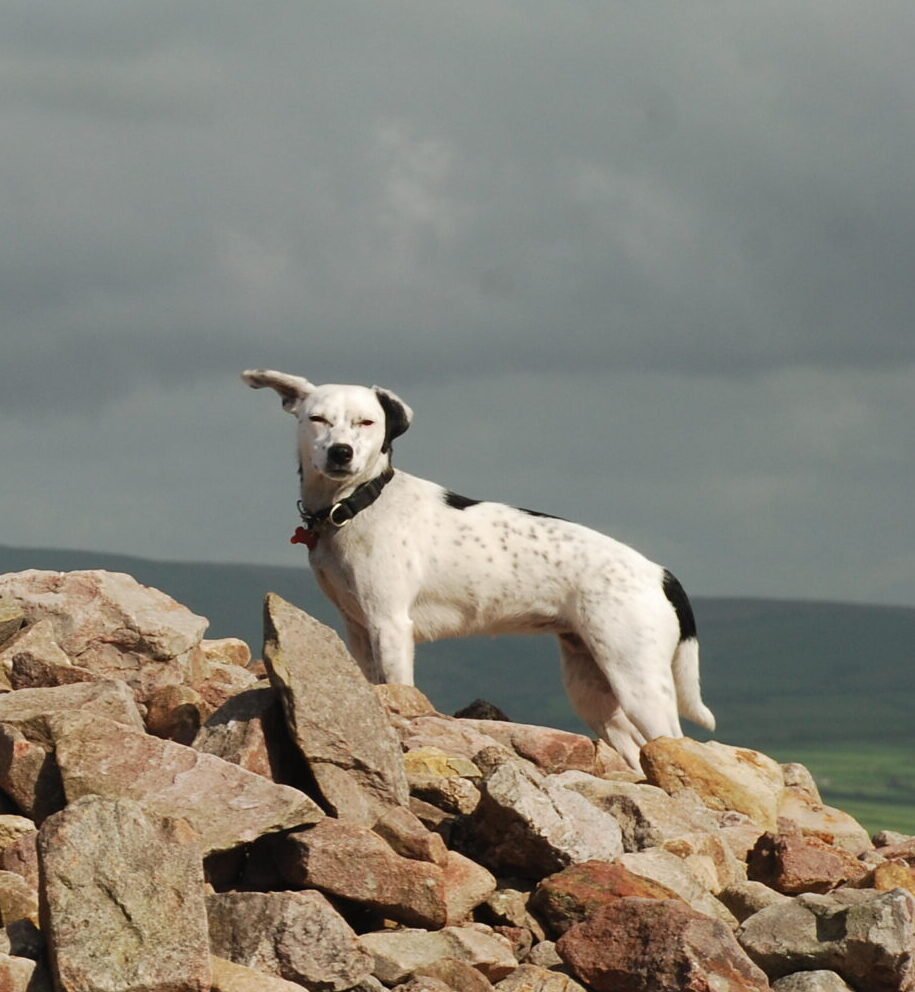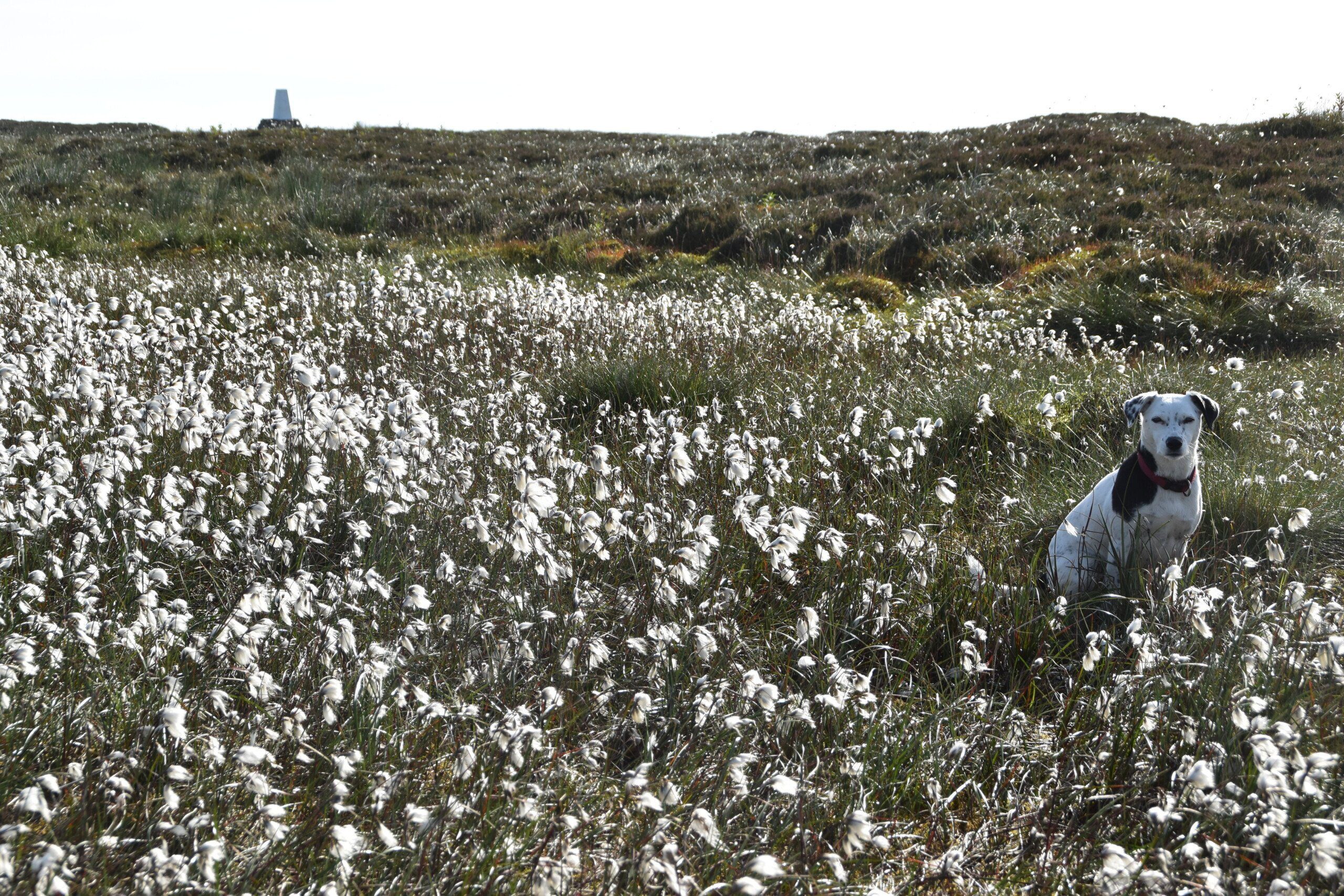All you need to know about taking your best friend on a long-distance hike
| Table of contents |
|---|
| Introduction |
| Can your dog complete a long-distance trail? |
| What breed is best for a long-distance walk? |
| Looking after your dog |
Introduction
Many are the rewards that await those prepared to make the extra effort required to bring their best friend on a long-distance trail.
But just as numerous are the potential pitfalls and disasters that can happen too.
As a sentient, sensible human being, you’ll know whether you want to walk a long-distance trail or not, and whether you’re capable of doing so. But you also know that chasing livestock is never a very good idea, and that traffic doesn’t stop for you if you just step out in the road, even if there is an injured squirrel limping along the pavement opposite. Hell, I reckon you have probably also learnt not to lick your genitals in public nor roll in sheep poo at every opportunity.
Now I hope I’m not casting unwarranted aspersions on your dog here, but I’m guessing your dog probably hasn’t.
So while you think your dog maybe the smartest creature you’ve ever encountered, most of the time you’ll have to do the thinking, and planning, on its behalf. And for every decision you make on your walk, you will have to factor in your dog too.
But that’s not to try to put you off bringing your dog. I do it, plenty of other people do it, and highly rewarding it is too. But you shouldn’t underestimate the amount of work involved in taking your dog on a super-sized ‘walkies’.
Indeed, just about every decision you make will be influenced by the fact that you’ve got a dog: how you plan to travel to the start of the trail, where you’re going to stay, how far you’re going to walk each day, where you’re going to rest and where you’re going to eat in the evening etc.
You should also be sure your dog can cope with (and will enjoy) walking 10 miles (16km) or more a day for several days in a row – and you need to prepare accordingly. Extra thought also needs to go into your itinerary.
But before we look at how you should plan for taking a dog along the trail, we should start by seeing whether you even should.
Can your dog walk a long-distance trail?
There are four basic requirements that your dog needs in order to walk a long-distance path:
- Your dog needs to have stamina
- Your dog needs to have the necessary level of fitness and be in good health
- Your dog needs to be well trained and obedient
- Your dog needs to enjoy it. Otherwise there’s no point bringing it on the trail in the first place.
Let’s now look at each of these in turn:
STAMINA
Stamina
Walking at least ten miles each day for a week or more is a lot more arduous than taking a short stroll around the streets where you live. But stamina is something you can work on and build up. Daisy has always been happy walking 8 miles a day or so, but after several weeks on the trails she can do 25-miles plus. Nevertheless, there’s no point trying to push your pet too much. You love your dog, don’t you? So you want it to be happy and healthy, correct? So let your dog improve its fitness and stamina – just as you improve yours – as you progress along the trail.
HEALTH & FITNESS
Health & Fitness
Linked to stamina, though slightly broader, is your dog’s fitness. In particular:
- Is your dog strong and agile enough to jump over stiles, or are you going to have to lift it over all the time?
- Does it have the strength in its legs to walk all those miles?
- Is it lean enough that it’s not going to be wheezing and panting all the way along the path?
OBEDIENCE
Obedience
Your dog needs to have mastered several vital skills before setting paw on a long-distance path.
In particular….
- Your dog needs to know that it can’t go into the next field before you.
- That it must come to heel immediately when called.
ENJOYMENT
Enjoyment
Unless you know that your dog is going to enjoy being on the trail, it’s cruel to bring them. Don’t assume that they will enjoy it, just because they’re a dog, and dogs like walkies. As I said above, there’s a world of difference between a 30-minute amble around the local park and a multi-day hike involving unfamiliar terrain, strange food and alien accommodation.
READ MORE
STAMINA
Stamina
Walking at least ten miles each day for a week or more is a lot more arduous than taking a short stroll around the streets where you live. But stamina is something you can work on and build up. Daisy has always been happy walking 8 miles a day or so, but after several weeks on the trails she can do 25-miles plus. Nevertheless, there’s no point trying to push your pet too much. You love your dog, don’t you? So you want it to be happy and healthy, correct? So let your dog improve its fitness and stamina – just as you improve yours – as you progress along the trail.
HEALTH & FITNESS
Health & Fitness
Linked to stamina, though slightly broader, is your dog’s fitness. In particular:
- Is your dog strong and agile enough to jump over stiles, or are you going to have to lift it over all the time?
- Does it have the strength in its legs to walk all those miles?
- Is it lean enough that it’s not going to be wheezing and panting all the way along the path?
OBEDIENCE
Obedience
Your dog needs to have mastered several vital skills before setting paw on a long-distance path.
In particular….
- Your dog needs to know that it can’t go into the next field before you.
- That it must come to heel immediately when called.
ENJOYMENT
Enjoyment
Unless you know that your dog is going to enjoy being on the trail, it’s cruel to bring them. Don’t assume that they will enjoy it, just because they’re a dog, and dogs like walkies. As I said above, there’s a world of difference between a 30-minute amble around the local park and a multi-day hike involving unfamiliar terrain, strange food and alien accommodation.
READ MORE
What breed
is best
for a long-
distance
walk?
Not every dog can walk for 10-20 miles per day, and for several days at a time. Many are simply too big and heavy, or too small, or just don’t have the necessary stamina.
Indeed, the only breed of dog that I regularly see attempting a long-distance walk are border collies. They are, of course, ideally suited to walking a long-distance trail. They (usually) have the necessary levels of stamina and fitness as well as the requisite intelligence. Just as importantly, they also have the kind of character and temperament that would enjoy a long-distance walk.
But they’re not the only breed that can attempt a hike lasting several days. The larger breeds of spaniel also seem to cope well. They certainly have the necessary energy (as their owners will doubtless confirm) Other breeds that have been recommended as suitable for a hike include Beagles, Labrador Retrievers, Pointers, Huskies and Rhodesian Ridgebacks.
As for my own dog, Daisy, she is a mongrel, though was advertised as a Parson Russell terrier, and that is the breed that she resembles most closely. She’s quite a bit smaller than many of the breeds listed above, but that was a deliberate choice on my part.
Why? Well, I wanted her to be small enough that I could pick her up and carry her should it be necessary to do so. Being small also means she can sit on my lap or under my seat on public transport. As an added bonus, small dogs also tend to be more likely to be accepted in B&Bs. That said, she has the longer legs of a typical Parsons – ideal for eating up the miles on a long hike.
Looking after your dog
To begin with, you need to make sure that your own dog is fully inoculated against the usual doggy illnesses, and also up to date with regard to worm pills (eg Drontal) and flea preventatives – they are, after all, following in the pawprints of many a dog before them, some of whom may well have left fleas or other parasites on the trail that now lie in wait for their next home to arrive.
Pet insurance is also a very good idea; if you’ve already got insurance, do check that it will cover a trip such as this.
On the subject of looking after your dog’s health, perhaps the most important implement you can take with you is the plastic tick remover, available from vets for at most a couple of quid. These removers, while fiddly, help you to remove the tick safely (ie without leaving its head behind, buried under the dog’s skin). Being in unfamiliar territory also makes it more likely that you and your dog could become separated. For this reason, make sure your dog has a tag with your contact details on it (a mobile phone number would be best if you are carrying one with you).
When to keep
your dog
on a lead…
● On cliff tops It’s a sad fact that, every year, a few dogs lose their lives falling over the edge of the cliffs. It usually occurs when they are chasing rabbits (which know where the cliff-edge is and are able, unlike your poor pooch, to stop in time).
● When crossing farmland, particularly in the lambing season (March-May) when your dog can scare the sheep, causing them to lose their young. Farmers are allowed by law to shoot at and kill any dogs that they consider are worrying their sheep. During lambing, most farmers would prefer it if you didn’t bring your dog at all.
The exception is if your dog is being attacked by cows. Every year there are several deaths in the UK caused by walkers being trampled as they tried to rescue their dogs from the attention of cattle. The advice in this instance is to let go of the lead, head speedily to a position of safety (usually the other side of the field gate or stile) and, once there, call your dog to you.
● On National Trust land, where it is compulsory to keep your dog on a lead.
● Around ground-nesting birds It’s important to keep your dog under control when crossing an area where certain species of birds nest on the ground. Most dogs love foraging around in the woods but make sure you have permission to do so; some woods are used as ‘nurseries’ for game birds and dogs are only allowed through them if they are on a lead.
What to pack for your dog
You’ve probably already got a good idea of what to bring to keep your dog alive and happy, but the following is a checklist:
● Food/water bowl Foldable cloth bowls are popular with walkers, being light and taking up little room in the rucksack. You can get also get a water-bottle-and-bowl combination, where the bottle folds into a ‘trough’ from which the dog can drink.
● Lead and collar An extendable one is probably preferable for this sort of trip. Make sure both lead and collar are in good condition – you don’t want either to snap on the trail, or you may end up carrying your dog until a replacement can be found.
● Medication You’ll know if you need to bring any lotions or potions.
● Bedding A simple blanket may suffice, or you can opt for something more elaborate if you aren’t carrying your own luggage.
● Tick remover
● Poo bags Essential.
● Hygiene wipes For cleaning your dog after it’s rolled in stuff.
● A favourite toy Helps prevent your dog from pining for the entire walk.
● Food/water Remember to bring treats as well as regular food to keep up the mutt’s morale. That said, if your dog is anything like mine the chances are they’ll spend most of the walk dining on rabbit droppings and sheep poo anyway.
● Corkscrew stake Available from camping or pet shops, this will help you to keep your dog secure in one place while you set up camp/doze.
● Raingear It can rain!
● Old towels For drying your dog.
How to carry it
When it comes to packing, I always leave an exterior pocket of my rucksack empty, or have somewhere on the outside of the rucksack where I can attach used poo bags (for deposit at the first bin we come to). I always like to keep all the dog’s kit together and separate from the other luggage (usually inside a plastic bag inside my rucksack). I have also seen several dogs sporting their own ‘doggy rucksack’, so they can carry their own food, water, poo etc – which certainly reduces the burden on their owner.
Cleaning up after your dog
It is extremely important that dog owners behave in a responsible way when walking the path. Dog excrement should be cleaned up. In towns, villages and fields where animals graze or which will be cut for silage, hay etc, you need to pick up and bag the poo.
Staying (and eating out) with your dog
As a dog owner, you’ve always got to plan ahead for where you are going to sleep at night. If you’re going to be staying in B&Bs, then you really need to book your room in advance. In the guide books we indicate which places accept dogs. But even so, most of those places that do advertise themselves as being dog friendly, only do so if you’ve booked your place in advance. The B&B often has only one or two rooms where dogs can stay, and in a few cases dogs need to sleep in a separate building. Some places make an additional charge (usually per night but occasionally per stay), while others may require a deposit which is refundable if the dog doesn’t make a mess.
YHA hostels do not permit them unless they are an assistance (guide) dog, though there are a few independent hostels where dogs are welcome, at least outside of high season.
Campsites tend to accept dogs, but again, always check first, and always keep your dog on a lead in the site.
When it comes to eating, most pub landlords allow dogs in at least a section of their pubs, and a few cafés do too, though not many restaurants allow dogs. Make sure you always ask first and ensure your dog doesn’t run around the pub but is secured to your table or a radiator.



